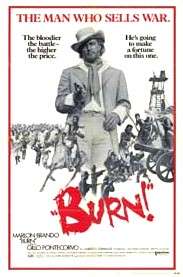Burn! (1969 film)
Burn! (Italian: Queimada) is a 1969 Italian war drama film directed by Gillo Pontecorvo and starring Marlon Brando, Evaristo Márquez and Renato Salvatori. The music was composed by Ennio Morricone. The fictional story focuses on the creation of a tropical republic in the Caribbean, and the events that follow it. Brando plays a British secret government agent, named after the American filibuster William Walker, who manipulates a slave revolt to serve the interests of empire and the sugar trade. The screenwriters also drew on the intelligence agent Edward Lansdale, who served the United States government in the Philippines and Indochina in the 1950s through 60s.
| Burn! | |
|---|---|
 English language theatrical poster | |
| Directed by | Gillo Pontecorvo |
| Produced by | Alberto Grimaldi |
| Written by | Franco Solinas Giorgio Arlorio |
| Starring | Marlon Brando Evaristo Márquez |
| Music by | Ennio Morricone |
| Cinematography | Marcello Gatti Giuseppe Ruzzolini |
| Edited by | Mario Morra |
Production company | Produzioni Europee Associati (PEA) Les Productions Artistes Associés |
| Distributed by | United Artists |
Release date |
|
Running time | 112 minutes (United States) 132 minutes (Restored) |
| Country | Italy |
| Language | Italian Spanish Portuguese |
Plot
In 1844, the British Admiralty sends Sir William Walker (Brando), an agent provocateur, to the fictional island of Queimada, a Portuguese[1] possession in the Lesser Antilles. Britain seeks to open the island to exploitation by the fictional Antilles Royal Sugar Company. Walker's task is to organize an uprising of African slaves against the Portuguese regime, which the British intend to replace with a government dominated by pliable white planters.
When he arrives in Queimada, Walker befriends José Dolores (Márquez), whom he entices to lead the slave revolt, and induces leading landowners to reject Portuguese rule. Dolores's rebellion is successful, and Walker arranges the assassination of the Portuguese governor in a nighttime coup. Walker establishes a puppet regime beholden to British sugar interests, headed by the idealistic but weak revolutionary Teddy Sanchez (Salvatori). Walker convinces Dolores to recognize the new regime and to surrender his arms, in exchange for the abolition of slavery. Having succeeded in his mission, he moves on to his next assignment in Indochina.
In 1848, Dolores–disgusted by the white government's collaboration with British interests–leads a second uprising, jeopardizing the Antilles Royal Sugar Company. After six years of the uprising, in 1854, the company returns Walker to Queimada with the consent of the British Admiralty, tasking him with suppressing the revolt and pacifying the island. Resentful of the company's exploitation of Queimada, President Sanchez is uncooperative. Sanchez is ousted and executed in a coup engineered by Walker, who establishes a regime wholly beholden to the company. British forces are invited to the island; guided by Walker, they rapidly quell the rebellion and capture Dolores. Walker attempts to save Dolores's life but the rebel leader rejects his assistance, asserting that freedom is earned, not received.
The government executes Dolores by hanging. Soon after, Walker, guilt stricken, is accosted as he prepares to depart Queimada. A man greets him just as Dolores did when Walker first arrived on the island, and then stabs him to death. Before dying, Walker looks around and sees himself surrounded by accusatory or passive looks of the poor people in the port.
Cast
- Marlon Brando as Sir William Walker, named after American filibuster William Walker
- Evaristo Márquez as José Dolores, named after José Dolores Estrada, the Nicaraguan general who defeated the historical Walker
- Renato Salvatori as Teddy Sanchez
- Dana Ghia as Francesca
- Valeria Ferran Wanani as Guarina
- Giampiero Albertini as Henry Thompson
- Carlo Palmucci as Jack
- Norman Hill as Shelton
- Thomas Lyons
- Joseph P. Persaud as Juanito
- Álvaro Medrano as Soldier
- Alejandro Obregón as English Major
- Enrico Cesaretti
Production
Brando had the opportunity to have a role on Butch Cassidy and the Sundance Kid and The Arrangement once again with Elia Kazan, but chose instead to work on this film. He also had to turn down a major role in Ryan's Daughter because of this film's production problems.
In his autobiography Brando: Songs My Mother Taught Me, Brando claims: "I did some of my best acting in Burn!".[2]
Reception
The film received critical acclaim in the U.S. and abroad. Based on 11 reviews collected by Rotten Tomatoes, the film has an overall approval rating from critics of 82%.[3] By comparison, its 2004 re-release was given an average score of 72 out of 100, based on 4 reviews, by Metacritic, which assigns a rating based on top reviews from mainstream critics.[4]
Natalie Zemon Davis reviewed the film from a historian's perspective and gave it high marks, arguing that it merges historical events that took place in Brazil, Cuba, Santo Domingo, Jamaica, and elsewhere.[5]
The character José Dolores inspired the logo of the socialist magazine Jacobin.[6]
See also
References
- The film was originally set on a Spanish island called Quemada, meaning "burnt", but it was changed to Portuguese after the Spanish government found it insulting; however, the language spoken in the film remained Spanish. Queimada (1969) on IMDb
- Brando, Marlon (1994). Brando: Songs My Mother Taught Me. New York: Random House. p. 364. ISBN 0-679-41013-9.
- Queimada / Burn! / The Mercenary (1969) at Rotten Tomatoes
- Burn! (re-release).
- Natalie Zemon Davis, Slaves on Screen: Film and Historical Vision (2002) ch 3
- Forbes, Remeike (Spring 2012). "The Black Jacobin. Our visual identity". Jacobin.
Further reading
- Davis, Natalie Zemon. Slaves on Screen: Film and Historical Vision (2002) ch 3
- Martin, Michael T., and David C. Wall, "The Politics of Cine-Memory: Signifying Slavery in the History Film," in Robert A. Rosenstone and Constantin Parvulesu, eds. A Companion to the Historical Film (Wiley-Blackwell, 2013), pp. 445–467.